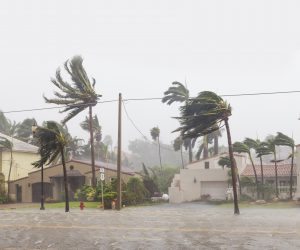Hope for the Best, Brace for the Worst
With an expectedly active 2024 Atlantic hurricane season on the horizon, local meteorologists emphasize the importance of taking precautions now to minimize panicking in the face of Mother Nature’s fury.

Without hesitation, WFTV meteorologist Brian Shields concisely summarizes what his fellow Floridians should expect from the 2024 Atlantic hurricane season.
“It is going to be incredibly active, there’s no doubt about it,” he affirms. “It is going to be one of the most active seasons on record because almost every ingredient we look at is pointing to a hyperactive hurricane season—that doesn’t mean a hurricane is going to hit me or a hurricane is going to hit you, but it means there will be a lot of named storms.”
A lot goes into forecasting what to expect from a hurricane season, which officially spans from June 1 to Nov. 30 even though storms can develop at any time. That includes considering what happens when an El Niño transitions to a more neutral stage—like it’s expected to later this summer—and that associated change in wind shears, as well as other variables like water temperatures and how much ocean-stabilizing Saharan dust comes off the west coast of Africa.
Since it’s never clear how the season will play out before it really even begins, experts advise that choosing preparation over panic can help ease Central Floridians’ anxieties. That means staying on top of developing storm reports, assembling and assessing a hurricane emergency kit that suits your household’s needs for several days, and ensuring that your various insurance policies are up-to-date. After all, it’s easier to get your house in order both literally and figuratively when the threat of a storm is still a far-off reality that hasn’t yet nudged you and your neighbors into survival mode.
“We try to drive home that hurricane season is coming to an area where there have been landfalls before,” says Megan Borowski, interim director and chief meteorologist for the Florida Public Radio Emergency Network. “Part of what you need to do now is evaluate your property, evaluate the needs of your family, figure out and identify your vulnerabilities, and then identify solutions or ways that you can be most prepared. You’ll want to do this ahead of time, when there isn’t a hurricane at your doorstep—that way, when the threat does come, you just go into autopilot and put your emergency plan into action, you’re not having emotions dictate your reaction and you already know what you have to do.”
Prediction models are updated every three decades to account for historic trends and to weed out outlier anomalies; going by data from the 1991-2020 hurricane seasons, both the National Oceanic and Atmospheric Administration (NOAA) and Colorado State University (CSU) note that an average Atlantic hurricane season typically translates to 14 tropical storms, seven named hurricanes and three major hurricanes (the latter is defined as a Category 3 storm or higher). And while NOAA hadn’t yet issued its seasonal outlook as of press time, CSU’s April 4 predictions anticipate 23 tropical storms, 11 hurricanes and five major ones.
It might be scary to consider that previous patterns point to an ever-increasing uptick in hurricanes each season, but part of that rise in predicted activity is because the technology behind hurricane forecasts has become incredibly sophisticated over the years.
But no matter how advanced storm-tracking tools are, it’s still all but impossible to tell what conditions will generate a hurricane until one develops, and even the path it’s expected to carve across a landmass is largely unclear until the weather event begins taking shape.
“I think the forecasts have been so good, which itself is great. But on the flip side, I feel like when a five-day forecast track is put out, when it’s splashed across social media that a storm track is pointed right at you five days from now, there’s a high dependency or believability that that is what’s going to happen—when I know that’s most likely going to change,” Shields says. “I think it needs to be known that the exact science is not there yet, especially with the intensity of storms. A storm could go from a Category 1 to a Category 5 hurricane in just about 24 hours. The science is great and it helps people prepare but, as far as things like the intensity goes, it’s still very very hard to forecast.”
That unpredictability is partly why experts advise hoping for the best but preparing for the worst. It also contributes to how meteorologists adapt their messages to the conditions in which they’re reporting, from tropical-storm development and strengthening hurricanes to imminent land hits, live storm coverage and announcing when the threat has finally passed—a critical notification, as clear skies don’t necessarily mean that storm surges and stagnant flood waters have abated.
“Before the storm, we’re focused on preparing, and a lot of that is impacts and timing, what are the hazards we’re expecting, when we expect the storm to arrive and when we expect conditions to be at their worst—that is crucial, because that’s how people can say, ‘Okay, this is the point where I need to be hunkered down or I need to be out of here,’” Borowski explains. “Once we get into storm coverage, that’s when we’re doing live radar tracking, tracking the impacts … During our highest level of storm coverage, we’ll bring in emergency managers and have them give their messaging to the public directly, whether it’s impacts for a particular area or shelter-in-place directives.”
They also emphasize that an active season doesn’t mean that Floridians are doomed to destruction and direct hits: Last year’s hurricane season was the fourth-most active Atlantic hurricane season on record, though The Sunshine State largely avoided catastrophe with “only” one storm making landfall.
But, as Shields points out, “it only takes that one storm” for a region to feel the fury of Mother Nature’s wrath. Those who were in the powerfully ruinous Category 4 Hurricane Idalia’s 2023 path of destruction, for example, have a much different recollection of how last year’s season played out than those who were fortunate enough to escape unscathed.
“A lot of people I’ve talked to mentioned that last season was ‘such a quiet hurricane season’ but based on the numbers, there were actually over 20 named storms—it’s just that most didn’t hit land,” he begins. “We hope that happens this year, but there could be upwards of 20 to 30 named storms out there, which does increase the odds that someone does get hit. But, again, there’s no way to tell where the hurricanes will go until we get a good handle on a pattern this summer.”
Navigating the aftermath is, of course, the most daunting prospect hurricane survivors face. And while there’s no diminishing or easing the tragedies of devastated land, lost homes and human casualties, digging out from the rubble isn’t something anyone has to face alone, thanks to emergency services and the basic mutual aid that neighbors can extend to one another when natural devastation cuts them off from the rest of the world. After all, the responsiveness of a community can be the difference between life and death for some—just assess your own safety risks before lending a helping hand first.
“If you have the resources to do so and you are safe, check in and look after your neighbors since you might be their only lifeline,” says Borowski. “Do not go out and try to mend a roof by yourself. But post-storm, if you know of a neighbor who might need assistance, help them out. Leave disaster recovery to the professionals like the fire department and the National Guard, but the more you can help your immediate area and your family and your friends, the more that opens up emergency managers to address the bigger issues.”
Resource guide
GENERATOR
Genstar Generator Services
Generator sales, installation and service
(407) 417-5553
GenstarService.com
OUTDOOR LIVING
MD Construction
Pool enclosures, screen enclosures, screen room, sunroom, patio covers and lanai
(321) 663-5203
MDConstructionFL.com
WINDOWS & DOORS
FL Shutters
Interior, exterior, hurricane shutters, retractable screens and architectural metalwork
(407) 850-9998
FLShutters.com
Florida Window & Door Solutions
Quality window and door replacement
(321) 203-4336
FloridaWDS.com






